
|
acetic acid |
acetic acid is a lipid of Fatty Acyls (FA) class. Acetic acid is associated with abnormalities such as Vitamin B 12 Deficiency. The involved functions are known as Excretory function. The related lipids are Propionate. |
89633 |
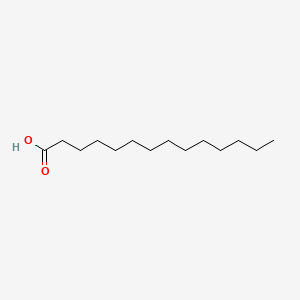
|
Tetradecanoic acid |
Tetradecanoic acid is a lipid of Fatty Acyls (FA) class. Tetradecanoic acid is associated with abnormalities such as Chronic lung disease, Infection, Spastic syndrome, Diabetes and Cardiovascular Diseases. The involved functions are known as Fatty acid biosynthetic process, Anabolism, lung alveolus development, 5-(carboxyamino)imidazole ribonucleotide mutase activity and Homeostasis. Tetradecanoic acid often locates in Structure of parenchyma of lung, Blood, Head, Membrane and Cytoplasmic matrix. The associated genes with Tetradecanoic acid are SLC33A1 gene, SFTPA1 gene, P4HTM gene, Polypeptides and GPR132 gene. The related lipids are Fatty Acids, Nonesterified Fatty Acids, palmitoleic acid, Phosphatidylglycerols and Butanols. |
5058 |

|
Linoleic acid |
Linoleic acid is a lipid of Fatty Acyls (FA) class. Linoleic acid is associated with abnormalities such as Diabetes Mellitus, Non-Insulin-Dependent, Metabolic syndrome, Obesity, Chronic Obstructive Airway Disease and Pneumonia. The involved functions are known as Insulin Resistance, Inflammation, Synthesis, Pathological accumulation of air in tissues and cytokine biosynthesis. The associated genes with Linoleic acid are TNF gene, CCL2 gene and TLR4 gene. The related lipids are palmitoleic acid, nervonic acid and Sphingolipids. |
5699 |

|
Linoelaidic acid |
Linoelaidic acid is a lipid of Fatty Acyls (FA) class. Linoelaidic acid is associated with abnormalities such as Obesity, Diabetes Mellitus, Non-Insulin-Dependent, Pneumonia, Chronic Obstructive Airway Disease and Metabolic syndrome. The involved functions are known as Metabolic Inhibition, Steroid biosynthesis, Signal Transduction, Insulin Resistance and Inflammation. Linoelaidic acid often locates in Mitochondria, Membrane and Cytoplasmic matrix. The associated genes with Linoelaidic acid are FFAR1 gene, C9orf7 gene, TNF gene, CCL2 gene and TLR4 gene. The related lipids are Fatty Acids, octadecadienoic acid, Steroids, methyl linoleate and Cyanoketone. |
10058 |

|
stearic acid |
stearic acid is a lipid of Fatty Acyls (FA) class. Stearic acid is associated with abnormalities such as Helminthiasis, Exanthema, Chronic disease, Obesity and Dyslipidemias. The involved functions are known as acyltransferase activity, Mutation, Cell division, cell fate and Fatty Acid Metabolism. Stearic acid often locates in membrane fraction, Mouse Liver, Membrane, Body tissue and Endoplasmic reticulum, membrane. The associated genes with stearic acid are Homologous Gene, ACLY gene, Transgenes, FATE1 gene and Alleles. The related lipids are Lysophospholipids, Stearic acid, Fatty Acids, cis-vaccenic acid and Phosphatidylserines. The related experimental models are Knock-out. |
5692 |
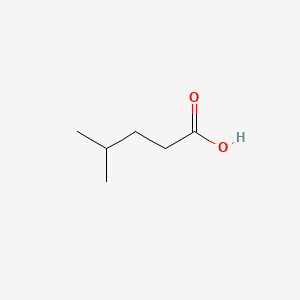
|
4-METHYLPENTANOIC ACID |
4-METHYLPENTANOIC ACID is a lipid of Fatty Acyls (FA) class. The involved functions are known as CoA-transferase activity. 4-methylpentanoic acid often locates in Cytosol. The related lipids are Fatty Acids and alpha-ketocaproic acid. |
126 |

|
Arachidonic acid |
Arachidonic acid is a lipid of Fatty Acyls (FA) class. Arachidonic acid is associated with abnormalities such as Atherosclerosis, Ischemia, Hypertensive disease, Hypertension induced by pregnancy and Vascular ring of aorta. The involved functions are known as Platelet aggregation, Anabolism, Ion Transport, Signal Transduction Pathways and Signal. Arachidonic acid often locates in Extracellular, Body tissue, Protoplasm, Tissue membrane and soluble. The associated genes with Arachidonic acid are CYP2J2 gene, CYP2E1 gene, Recombinant Proteins, POR gene and P4HTM gene. The related lipids are Fatty Acids, Glycerophospholipids, Steroids, octadecadienoic acid and 9-hydroxy-10,12-octadecadienoic acid. The related experimental models are Mouse Model and Knock-out. |
22864 |
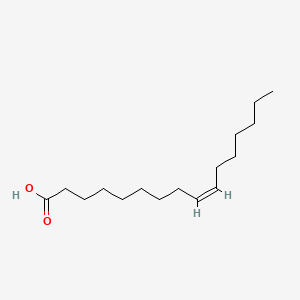
|
cis-9-palmitoleic acid |
Cis-9-palmitoleic acid is a lipid of Fatty Acyls (FA) class. |
694 |
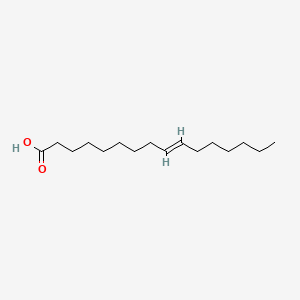
|
trans-9-palmitoleic acid |
Trans-9-palmitoleic acid is a lipid of Fatty Acyls (FA) class. |
468 |
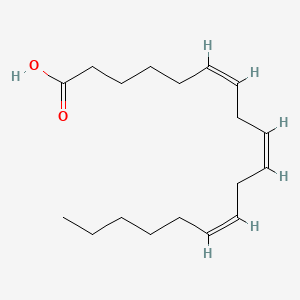
|
gamma-Linolenic acid |
Gamma-linolenic acid is a lipid of Fatty Acyls (FA) class. The involved functions are known as Drug Interactions. Gamma-linolenic acid often locates in Articular system. |
1919 |

|
alpha-linolenic acid |
Alpha-linolenic acid is a lipid of Fatty Acyls (FA) class. Alpha-linolenic acid is associated with abnormalities such as Coronary heart disease, abnormal fragmented structure, Arterial thrombosis and Subarachnoid Hemorrhage. The involved functions are known as Anabolism, Signal, Transcription, Genetic, Saturated and Regulation. Alpha-linolenic acid often locates in Blood, Body tissue, Plasma membrane, Hepatic and peroxisome. The associated genes with alpha-linolenic acid are FATE1 gene, volicitin, CYP2U1 gene, CYP1A2 gene and CYP2J2 gene. The related lipids are Fatty Acids, Dietary Fatty Acid, stearidonic acid and Fatty Acids, Nonesterified. |
4231 |
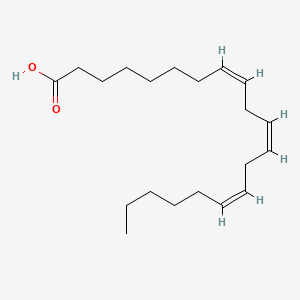
|
bishomo-gamma-linolenic acid |
Bishomo-gamma-linolenic acid is a lipid of Fatty Acyls (FA) class. Bishomo-gamma-linolenic acid is associated with abnormalities such as Diabetes, Obesity, Hypertensive disease, Cirrhosis and Hepatorenal Syndrome. The involved functions are known as Oxidation, Process, Metabolic Inhibition, epoxide hydrolase activity and Signal Transduction Pathways. Bishomo-gamma-linolenic acid often locates in Protoplasm, Cytoplasmic matrix, soluble, Membrane and Tissue membrane. The associated genes with bishomo-gamma-linolenic acid are P4HTM gene, IMPACT gene, arginine methyl ester, CYP gene and PTGS1 gene. The related lipids are Fatty Acids, 17-octadecynoic acid, Lipopolysaccharides, palmitoleic acid and nervonic acid. The related experimental models are Knock-out and Mouse Model. |
2467 |

|
DHA |
Dha is a lipid of Fatty Acyls (FA) class. Dha is associated with abnormalities such as Atherosclerosis, Consumption-archaic term for TB, Chronic disease, Cardiovascular Diseases and Diabetes Mellitus, Non-Insulin-Dependent. The involved functions are known as Inflammation, Oxidation, fatty acid oxidation, Fatty Acid Metabolism and Lipid Metabolism. Dha often locates in Hepatic, Protoplasm, Mucous Membrane, Epithelium and outer membrane. The associated genes with DHA are IMPACT gene, FATE1 gene, GAPDH gene, THOC4 gene and SLC33A1 gene. The related lipids are stearidonic acid, Fatty Acids, Total cholesterol, Lipopolysaccharides and Dietary Fatty Acid. The related experimental models are Mouse Model, Transgenic Model, Animal Disease Models and Arthritis, Experimental. |
11054 |

|
7-octadecynoic acid |
7-octadecynoic acid is a lipid of Fatty Acyls (FA) class. |
8379 |

|
EPA |
Epa is a lipid of Fatty Acyls (FA) class. |
5952 |

|
(r)-3-hydroxybutanoic acid |
(r)-3-hydroxybutanoic acid is a lipid of Fatty Acyls (FA) class. |
2710 |
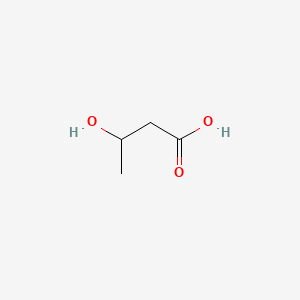
|
3-hydroxybutyric acid |
3-hydroxybutyric acid is a lipid of Fatty Acyls (FA) class. 3-hydroxybutyric acid is associated with abnormalities such as Ketosis. The involved functions are known as fatty acid oxidation, Oxidation, Synthesis, inhibitors and glucose metabolism. 3-hydroxybutyric acid often locates in Blood, Adipose tissue, Protoplasm, Hepatic and Extracellular. The associated genes with 3-hydroxybutyric acid are Genes, Developmental and Oncogene, RET. The related lipids are Fatty Acids, Nonesterified, 6-hydroxyhexanoate, tributyrin, 3-Hydroxyvalerate and Valerates. |
4735 |
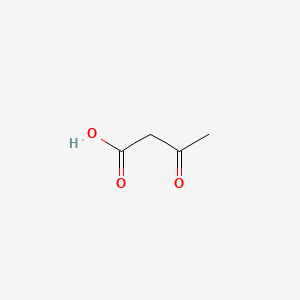
|
Acetoacetic acid |
Acetoacetic acid is a lipid of Fatty Acyls (FA) class.Acetoacetic acid is associated with abnormalities such as Dehydration. The involved functions are known as Biochemical Reaction, intracellular signal transduction, fatty acid elongation, Cytokinesis and Mass-to-Charge Ratio. The associated genes with Acetoacetic acid are CFB gene and mersacidin. Acetoacetic acidis associated with Carbon, Acids, Potassium, Acetoacetic acid and Oximes. The related lipids are Nonesterified Fatty Acids and Stearates. |
2523 |
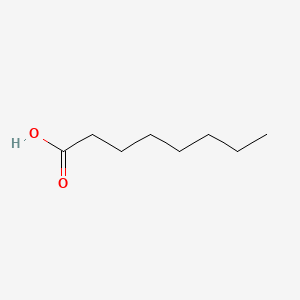
|
octanoic acid |
octanoic acid is a lipid of Fatty Acyls (FA) class. Octanoic acid is associated with abnormalities such as Ischemia, Diabetes Mellitus, Non-Insulin-Dependent, Diabetes, Cardiomyopathies and Obesity. The involved functions are known as Anabolism, 5-(carboxyamino)imidazole ribonucleotide mutase activity, Citric Acid Cycle, Metabolic Inhibition and Excretory function. Octanoic acid often locates in Pore, Protoplasm, Endothelium, Mitochondria and Muscle. The associated genes with octanoic acid are P4HTM gene, CPT1A gene, HADH gene, ACSL1 Gene and CD36 gene. The related lipids are Fatty Acids, Nonesterified Fatty Acids, Oleates, Palmitates and hexanoic acid. |
3349 |

|
Pyruvic acid |
Pyruvic acid is a lipid of Fatty Acyls (FA) class. |
27047 |

|
6-aminohexanoic acid |
6-aminohexanoic acid is a lipid of Fatty Acyls (FA) class. 6-aminohexanoic acid is associated with abnormalities such as Blood Clot, Myocardial Infarction, Cerebrovascular accident, Renal impairment and Scoliosis, unspecified. The involved functions are known as Fibrinolysis, Agent, Hemorrhage, plasminogen activation and inhibitors. 6-aminohexanoic acid often locates in Chest, Blood, Body tissue, peritoneal and Plasma membrane. The associated genes with 6-aminohexanoic acid are P4HTM gene, BSND gene, MTPN gene, NDUFS4 gene and Homologous Gene. The related lipids are Phosphatidylserines and Butyric Acid. |
3685 |

|
4-aminobutyric acid |
4-aminobutyric acid is a lipid of Fatty Acyls (FA) class. 4-aminobutyric acid is associated with abnormalities such as Epilepsy and Premenstrual syndrome. The involved functions are known as Binding (Molecular Function), neuron survival, Process, Uptake and physiological aspects. 4-aminobutyric acid often locates in Microglial, Neurofilament, Neuraxis, Brain region and Neurites. The associated genes with 4-aminobutyric acid are arginine methyl ester, SLC33A1 gene, NKS1 gene, P4HTM gene and ITSN2 gene. The related lipids are pregnenolone sulfate, pregnane-20-one, Pregnanes, Steroids and endogenous steroids. |
19702 |

|
Lipoic acid |
Lipoic acid is a lipid of Fatty Acyls (FA) class. |
7940 |
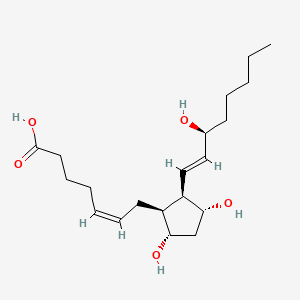
|
15-F2t-IsoP |
15-f2t-isop is a lipid of Fatty Acyls (FA) class. 15-f2t-isop is associated with abnormalities such as Diabetes Mellitus, Acute coronary syndrome, Risk factor, cardiovascular, thrombocytosis and Chronic ischemic heart disease NOS. The involved functions are known as Anabolism, Inflammation, Lipid Peroxidation, Excretory function and Platelet Activation. The associated genes with 15-F2t-IsoP are PTGS2 gene. |
2120 |
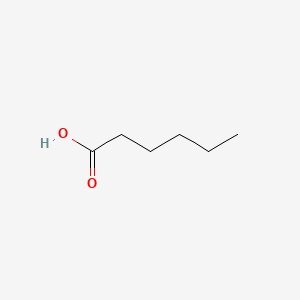
|
HEXANOIC ACID |
HEXANOIC ACID is a lipid of Fatty Acyls (FA) class. Hexanoic acid is associated with abnormalities such as Obesity, Ileoanal Pouches, Ulcerative Colitis, Ulcerative colitis, quiescent and Diabetes Mellitus, Non-Insulin-Dependent. The involved functions are known as Binding (Molecular Function), Anabolism, Adjudication, enzyme activity and Process. Hexanoic acid often locates in Membrane, Tissue membrane, Microsomes, Liver, Microsomes and Mitochondria. The associated genes with HEXANOIC ACID are SH2D1A gene, Fusion Protein and MAPK3 gene. The related lipids are hexanoic acid, Fatty Acids, Butyric Acid, Propionate and Palmitates. |
1028 |
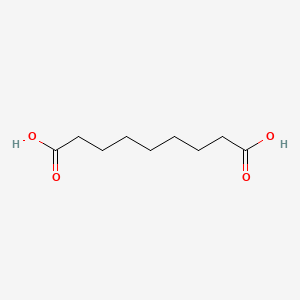
|
Azelaic acid |
Azelaic acid is a lipid of Fatty Acyls (FA) class. Azelaic acid is associated with abnormalities such as Bacterial Infections and Infection. The involved functions are known as Anabolism, Signal Transduction, Plant Immunity, Signal and Signal Transduction Pathways. Azelaic acid often locates in Body tissue. The associated genes with Azelaic acid are AZI1 gene, FKBPL gene and MLL gene. The related lipids are sebacic acid. |
783 |
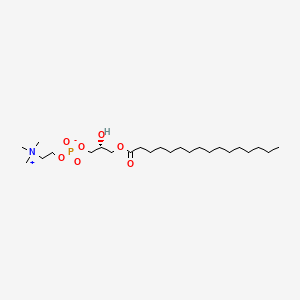
|
1-Palmitoyl-sn-glycero-3-phosphocholine |
1-Palmitoyl-sn-glycero-3-phosphocholine is a lipid of Glycerophospholipids (GP) class. 1-palmitoyl-sn-glycero-3-phosphocholine is associated with abnormalities such as Intrahepatic Cholestasis and Dysentery, Shigella dysenteriae. The involved functions are known as Homeostasis, Signal Transduction, Saturated, mRNA Expression and Synthesis. 1-palmitoyl-sn-glycero-3-phosphocholine often locates in Hepatic. The associated genes with 1-Palmitoyl-sn-glycero-3-phosphocholine are PPARA gene, TGFBR2 gene, SMAD3 gene and PLA2G6 gene. The related lipids are Fatty Acids, palmitoyl lysophosphatidylcholine, LYSO-PC and 1-palmitoyl-2-hydroxy-sn-glycero-3-phosphocholine. |
135 |
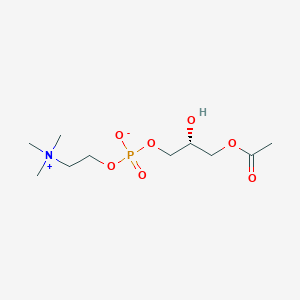
|
Lysophosphatidylcholine |
Lysophosphatidylcholine is a lipid of Glycerophospholipids (GP) class. Lysophosphatidylcholine is associated with abnormalities such as Ischemia, Obesity, Diabetes Mellitus, Non-Insulin-Dependent, Fatty Liver and Atherosclerosis. The involved functions are known as Inflammation, antagonists, Signal Transduction, Signal Pathways and Saturated. Lysophosphatidylcholine often locates in Body tissue, Head, integral to membrane, Membrane and Extracellular. The associated genes with Lysophosphatidylcholine are RHOA gene, Homologous Gene, GPR4 gene, GPR68 gene and TRPV2 gene. The related lipids are Nonesterified Fatty Acids, lysophosphatidylethanolamine, Lysophosphatidylcholines, Phosphatidylserines and 25-hydroxycholesterol. The related experimental models are Knock-out and Disease model. |
4395 |

|
Prostaglandin E2 |
Prostaglandin E2 is a lipid of Fatty Acyls (FA) class. Prostaglandin e2 is associated with abnormalities such as Renal glomerular disease, Arthritis, Degenerative polyarthritis, Pancreatitis and Rheumatoid Arthritis. The involved functions are known as enzyme pathway, Atherogenesis, Anabolism, inhibitors and Oxidants. Prostaglandin e2 often locates in Tissue membrane, Blood, Extracellular, Membrane and Protoplasm. The associated genes with Prostaglandin E2 are PTGS2 gene, TP53 gene, TNFRSF5 gene, FASTK Gene and TNF gene. The related lipids are Lipopolysaccharides, Steroids, monooxyethylene trimethylolpropane tristearate, Fatty Acids, Unsaturated and Promega. The related experimental models are Arthritis, Adjuvant-Induced, Xenograft Model, Experimental Autoimmune Encephalomyelitis, Cancer Model and Knock-out. |
49278 |
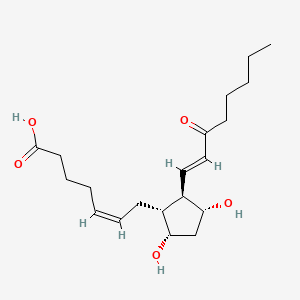
|
15-keto-PGF2alpha |
15-keto-pgf2alpha is a lipid of Fatty Acyls (FA) class. |
74 |

|
11beta-PGF2 |
11beta-pgf2 is a lipid of Fatty Acyls (FA) class. |
15009 |

|
Thromboxane b2 |
Thromboxane b2 is a lipid of Fatty Acyls (FA) class. Thromboxane b2 is associated with abnormalities such as endothelial dysfunction, Diabetes Mellitus, Non-Insulin-Dependent, Diabetes Mellitus, Ischemia and Thrombocytosis. The involved functions are known as Platelet Activation, Excretory function, Anabolism, Inflammation and mRNA Expression. Thromboxane b2 often locates in Endothelium, Hepatic and Microsomes, Liver. The associated genes with Thromboxane b2 are PTGS2 gene, prothrombin fragment 2 and CCL14 wt Allele. |
10175 |
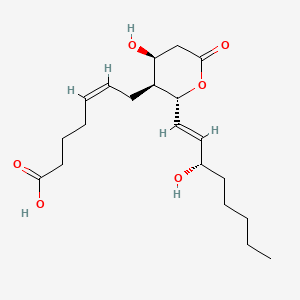
|
11-dehydro-TXB2 |
11-dehydro-txb2 is a lipid of Fatty Acyls (FA) class. 11-dehydro-txb2 is associated with abnormalities such as endothelial dysfunction, Risk factor, cardiovascular, Acute coronary syndrome, thrombocytosis and Chronic ischemic heart disease NOS. The involved functions are known as Platelet Activation, Excretory function, Anabolism, Inflammation and Lipid Peroxidation. The associated genes with 11-dehydro-TXB2 are PTGS2 gene. |
381 |
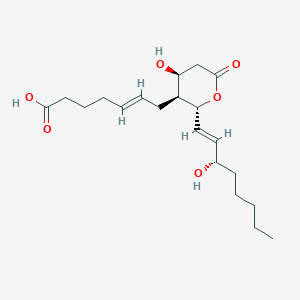
|
11-dehydro-txb2 |
|
98 |
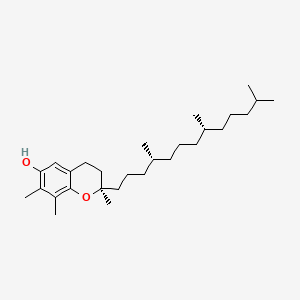
|
gamma-tocopherol |
Gamma-tocopherol is a lipid of Prenol Lipids (PR) class. The involved functions are known as 5-(carboxyamino)imidazole ribonucleotide mutase activity, Adverse effects, Longterm Effects, Luteal Phase and Drug Interactions. Gamma-tocopherol often locates in Blood. The related lipids are Total cholesterol. |
1377 |
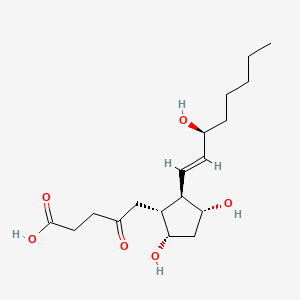
|
2,3-dinor, 6-keto-PGF1alpha |
2,3-dinor, 6-keto-pgf1alpha is a lipid of Fatty Acyls (FA) class. |
347 |
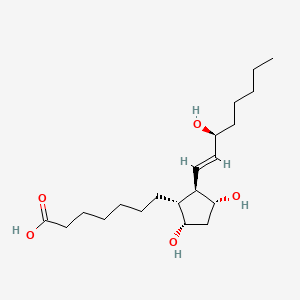
|
PGF1alpha |
Pgf1alpha is a lipid of Fatty Acyls (FA) class. |
418 |

|
Leukotriene b4 |
Leukotriene b4 is a lipid of Fatty Acyls (FA) class. The involved functions are known as Chemotaxis, release of sequestered calcium ion into cytoplasm and Polymerization. Leukotriene b4 often locates in Protoplasm. The associated genes with Leukotriene b4 are phallacidin. |
9311 |
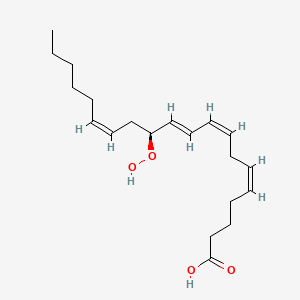
|
12S-HpETE |
12s-hpete is a lipid of Fatty Acyls (FA) class. |
211 |
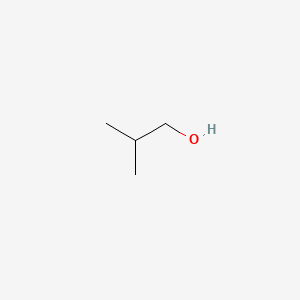
|
2-methyl-1-propanol |
2-methyl-1-propanol is a lipid of Fatty Acyls (FA) class. 2-methyl-1-propanol is associated with abnormalities such as FRIEDREICH ATAXIA 1, Amelia, Tuberculosis, purging and Tuberculosis, Pulmonary. The involved functions are known as Regulation, Oxidation-Reduction, Fermentation, Biochemical Pathway and Glycolysis. 2-methyl-1-propanol often locates in Protoplasm, Chromosomes, Human, Pair 7, BL21, Chromosomes and Cell metabolite. The associated genes with 2-methyl-1-propanol are ADH1B gene, LDHA gene, Operon, AAAS gene and SLC7A3 gene. The related lipids are Butanols, Fatty Alcohols, 1-Butanol, Fatty Acids and cyclopropane fatty acids. The related experimental models are Knock-out. |
758 |
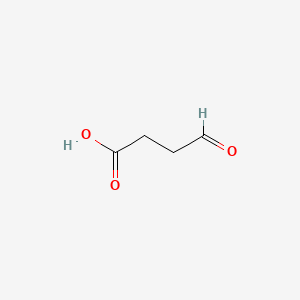
|
Succinic acid semialdehyde |
Succinic acid semialdehyde is a lipid of Fatty Acyls (FA) class. |
546 |

|
(e,e,e,e)-squalene |
(e,e,e,e)-squalene is a lipid of Fatty Acyls (FA) class. (e,e,e,e)-squalene is associated with abnormalities such as Hypercholesterolemia and Cataract. The involved functions are known as Process, metaplastic cell transformation, Protein Overexpression, Anabolism and Biosynthetic Pathways. (e,e,e,e)-squalene often locates in Membrane, Protoplasm, Plasma membrane, Tissue membrane and Back. The associated genes with (e,e,e,e)-squalene are Genome, IMPACT gene, GAPDH gene, GTF2I gene and Chromatin. The related lipids are Membrane Lipids, cycloartenol, Sterols, Fatty Acids and Nonesterified Fatty Acids. |
1766 |

|
Platelet activating factor |
Platelet activating factor is a lipid of Glycerophospholipids (GP) class. Platelet activating factor is associated with abnormalities such as Atherosclerosis, Acute cholecystitis without calculus, Cholecystitis, Colitis and Cholecystitis, Acute. The involved functions are known as Cell Survival, Metabolic Inhibition, lipid oxidation, Apoptosis and Oxidation. Platelet activating factor often locates in soluble, Cellular Membrane, Smooth muscle (tissue), Intima and Tissue specimen. The associated genes with Platelet activating factor are apolipoprotein A-I Milano, Homologous Gene, TSPO gene, HBEGF gene and SLC33A1 gene. The related lipids are Hydroxycholesterols, Liposomes, 25-hydroxycholesterol, Lysophosphatidylcholines and Lipopolysaccharides. The related experimental models are Knock-out, Mouse Model and Transgenic Model. |
7383 |

|
PE(15:0/20:0) |
PE(15:0/20:0) is a lipid of Glycerophospholipids (GP) class. Pe(15:0/20:0) is associated with abnormalities such as Exanthema, Infection, Painful Bladder Syndrome, Obesity and Fatty Liver. The involved functions are known as conjugation, Transcription, Genetic, Sinking, Autophagy and Protein Biosynthesis. Pe(15:0/20:0) often locates in membrane fraction, soluble, Membrane, Body tissue and Tissue membrane. The associated genes with PE(15:0/20:0) are GABARAPL2 gene, ATG10 gene, ATG12 gene, SLC33A1 gene and GABARAP gene. The related lipids are Liposomes, Lipopolysaccharides, Phosphatidylserines, Membrane Lipids and Cardiolipins. The related experimental models are Knock-out and Cancer Model. |
723 |

|
tacrolimus |
Tacrolimus is a lipid of Polyketides (PK) class. Tacrolimus is associated with abnormalities such as Renal glomerular disease. The involved functions are known as inhibitors, Fungicidal activity, Metabolic Inhibition, Excretory function and Dephosphorylation. Tacrolimus often locates in Hepatic, Mitochondrial matrix and Inner mitochondrial membrane. The associated genes with Tacrolimus are RHOA gene and BGN gene. |
12730 |

|
erythromycin |
erythromycin is a lipid of Polyketides (PK) class. Erythromycin is associated with abnormalities such as Systemic Inflammatory Response Syndrome, Pneumonia, Infection, Pneumococcal Infections and Exanthema. The involved functions are known as Pharmacodynamics, Sterility, Agent, Drug Kinetics and Adjudication. Erythromycin often locates in Blood, peritoneal, Extracellular, Ribosomes and apicoplast. The associated genes with erythromycin are P4HTM gene, SLC33A1 gene, FAM3B gene, Operon and Homologous Gene. The related lipids are Hydroxytestosterones, Steroids, Propionate, Mycolic Acids and campesterol. The related experimental models are Mouse Model and Knock-out. |
19871 |

|
Azithramycine |
Azithramycine is a lipid of Polyketides (PK) class. Azithramycine is associated with abnormalities such as Respiratory Tract Infections, Pneumonia, Lower respiratory tract infection, Infection and Nonspecific urethritis. The involved functions are known as Lysis, Selection, Genetic, Mutation, Relapse and Adaptation. Azithramycine often locates in Blood, Respiratory System, Genitourinary system, Back and Chest. The associated genes with Azithramycine are Genes, rRNA, Genome, RPL22 gene, OPRM1 gene and tryptic soy broth. The related lipids are Liposomes, Phosphatidylserines, Promega, Lipopolysaccharides and Steroids. The related experimental models are Mouse Model, Knock-out and Tissue Model. |
7835 |

|
clarithromycin |
clarithromycin is a lipid of Polyketides (PK) class. Clarithromycin is associated with abnormalities such as Helicobacter Pylori Infection, Infection, Coinfection, Gastritis and Peptic Ulcer. The involved functions are known as Point Mutation, Increased Sensitivy, Bacterial resistance, urease activity and Mutation. Clarithromycin often locates in Blood, Gastric mucosa, Biopsy sample, Respiratory System and Entire gastrointestinal tract. The associated genes with clarithromycin are Genes, rRNA, rRNA Operon, Genome, HM13 gene and GDF15 gene. The related lipids are 9,11-linoleic acid, Steroids, Lysophosphatidylcholines, Lipopolysaccharides and 4-hydroxycholesterol. The related experimental models are Mouse Model, Knock-out and Experimental Pneumococcal Meningitis. |
10449 |

|
minocycline |
minocycline is a lipid of Polyketides (PK) class. Minocycline is associated with abnormalities such as Infection, Soft Tissue Infections, Septicemia, Chronic hyponatremia and Lesion of brain. The involved functions are known as Pharmacodynamics, Gene Expression, Transcriptional Activation, Regulation and Process. Minocycline often locates in Ribosomes, 50S ribosomal subunit, Blood, Skin and Immune system. The associated genes with minocycline are THEMIS gene, KCNK2 gene, RBFOX3 gene, PIWIL2 gene and P4HTM gene. The related lipids are Lipopolysaccharides, Promega, Steroids, Liposomes and Octanols. The related experimental models are Mouse Model, Experimental Autoimmune Encephalomyelitis, Genetically Engineered Mouse, Disease model and spinal model. |
9780 |

|
(-)-Epigallocatechin gallate |
(-)-Epigallocatechin gallate is a lipid of Polyketides (PK) class. (-)-epigallocatechin gallate is associated with abnormalities such as IMMUNE SUPPRESSION, Infection, Nodule, Lymphopenia and Tumor Immunity. The involved functions are known as Apoptosis, Cellular Immune Response, Specific immune response, Signal and Infiltration. (-)-epigallocatechin gallate often locates in Immune system, Cytoplasmic Granules, Skin, Protoplasm and Body tissue. The associated genes with (-)-Epigallocatechin gallate are C8orf4 gene, Genes, vpr, MAPK8 gene, P4HTM gene and GAG Gene. The related lipids are Promega, Lipopolysaccharides, Palmitates, Fatty Acids and Sphingolipids. The related experimental models are Mouse Model, Xenograft Model, Transgenic Model, Experimental Autoimmune Encephalomyelitis and Arthritis, Collagen-Induced. |
6551 |

|
quercetin |
quercetin is a lipid of Polyketides (PK) class. Quercetin is associated with abnormalities such as Coronary heart disease, Myocardial Infarction, Cirrhosis, Coronary Arteriosclerosis and Vascular ring. The involved functions are known as Vasodilation, physiological aspects, Fermentation, Process and Ingredient. Quercetin often locates in Arterial system, Endothelium, Skin, Endothelium, Vascular and Tissue specimen. The associated genes with quercetin are P4HTM gene, SULT gene, UGT1A1 gene, ARHGAP26 gene and PLXNB1 gene. The related lipids are blood lipid, Promega, Steroids, Phosphatidylserines and Fatty Acids. The related experimental models are Knock-out, Mouse Model, Xenograft Model, Tissue Model and Cancer Model. |
5377 |

|
hesperidin |
(2S)-5-hydroxy-2-(3-hydroxy-4-methoxyphenyl)-4-oxo-3,4-dihydro-2H-chromen-7-yl 6-O-(6-deoxyhexopyranosyl)hexopyranoside is a lipid of Polyketides (PK) class. (2s)-5-hydroxy-2-(3-hydroxy-4-methoxyphenyl)-4-oxo-3,4-dihydro-2h-chromen-7-yl 6-o-(6-deoxyhexopyranosyl)hexopyranoside is associated with abnormalities such as Osteoporosis, Postmenopausal, estrogen deficiency, Chronic venous insufficiency, Neurodegenerative Disorders and Cerebrovascular accident. The involved functions are known as Sweetening Agents, Vmax, enzyme activity, Fermentation and Regulation. (2s)-5-hydroxy-2-(3-hydroxy-4-methoxyphenyl)-4-oxo-3,4-dihydro-2h-chromen-7-yl 6-o-(6-deoxyhexopyranosyl)hexopyranoside often locates in Entire gastrointestinal tract, soluble, Entire bony skeleton, Trabecular substance of bone and Blood. The associated genes with (2S)-5-hydroxy-2-(3-hydroxy-4-methoxyphenyl)-4-oxo-3,4-dihydro-2H-chromen-7-yl 6-O-(6-deoxyhexopyranosyl)hexopyranoside are MTPN gene, GLUCOSIDASE, STN gene, SLC33A1 gene and GHRL gene. The related lipids are Total cholesterol and blood lipid. The related experimental models are Arthritis, Collagen-Induced. |
1455 |

|
phorbol 13-acetate 12-myristate |
Phorbol 13-acetate 12-myristate is a lipid of Prenol Lipids (PR) class. The involved functions are known as DNA Fragmentation, Phosphorylation and Irritation. Phorbol 13-acetate 12-myristate often locates in low-density lipoprotein particle. The associated genes with phorbol 13-acetate 12-myristate are FPR1 gene and ABCB1 gene. |
40921 |

|
Sphingosine 1-phosphate |
Sphingosine 1-phosphate is a lipid of Sphingolipids (SP) class. Sphingosine 1-phosphate is associated with abnormalities such as Infection, Painful Bladder Syndrome, Atherosclerosis, Hyperglycemia and Rheumatoid Arthritis. The involved functions are known as Phosphorylation, Regulation, enzyme activity, Energy Absorption and Vascular Permeability. Sphingosine 1-phosphate often locates in Endothelium, Tissue membrane, Vascular System, Protoplasm and Microfilaments. The associated genes with Sphingosine 1-phosphate are MBTPS1 gene, FBXL15 gene, TEK gene, NTRK1 gene and Gene Family. The related lipids are Promega, Lipopolysaccharides, lysophosphatidic acid, Lysophosphatidylcholines and Lysophospholipids. The related experimental models are Knock-out, Mouse Model, Transgenic Model, Disease model and Experimental Autoimmune Encephalomyelitis. |
2005 |
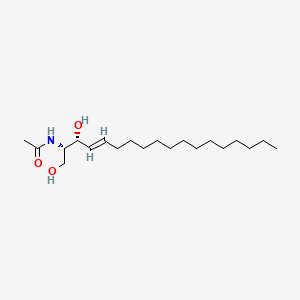
|
N-acetylsphingosine |
N-acetylsphingosine is a lipid of Sphingolipids (SP) class. N-acetylsphingosine is associated with abnormalities such as Morphologically altered structure, Atherosclerosis, Cardiovascular Diseases, Hyperinsulinism and Gigantism. The involved functions are known as inhibitors, anti-apoptosis, Apoptosis, Dephosphorylation and immunoreactivity. N-acetylsphingosine often locates in Plasma membrane, Mitochondria, Pore, Membrane and Cytoplasmic matrix. The associated genes with N-acetylsphingosine are EGR3 gene, CFB gene, FATE1 gene, P4HTM gene and PFDN4 gene. The related lipids are Sphingolipids, Cardiolipins, Glycerophospholipids, dihydroceramide and Phosphatidic Acid. |
633 |

|
cholesterol |
cholesterol is a lipid of Sterol Lipids (ST) class. Cholesterol is associated with abnormalities such as Trypanosomiasis, Chagas Disease, Cleft Palate, Chondrodysplasia punctata 2, X-linked dominant and Child syndrome. The involved functions are known as Blood Circulation, Sterol Biosynthesis Pathway, Receptor Mediated Endocytosis, Methylation and Signal. Cholesterol often locates in Animal tissue, Blood, Membrane, Plasma membrane and peroxisome. The associated genes with cholesterol are MBD2 gene, SIM, SLC33A1 gene, Genome and NSDHL gene. The related lipids are Sterols, zymosterol, fecosterol, Total cholesterol and 7-dehydrocholesterol. The related experimental models are Mouse Model, Knock-out, Genetically Engineered Mouse and Disease model. |
98461 |























































